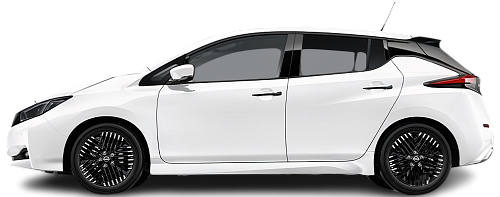Mitsubishi i-MiEV Gen 1 vs Nissan Leaf 60 kWh
Struggling to Decide? Let AI Help!
Your AI Summary Is Ready!
General Info
The Nissan Leaf 60 kWh (2022-…) is currently produced, it has a starting price of $37330. The Mitsubishi i-MiEV Gen 1 (2010-2021) has been discontinued. You can find it for as low as $2995 on the used car market.
The two vehicles share the same body style: Hatchback.
| Property | Mitsubishi i-MiEV Gen 1 | Nissan Leaf 60 kWh |
|---|---|---|
| Years of Production | 2010-2021 | 2022-… |
| Current Status | Discontinued | Produced |
| Country of Manufacture | Japan | Japan, UK, USA |
| Body Style | Hatchback | Hatchback |
| Market Availability | EU, USA | EU, USA |
| Price USA (New) | - Price USA (New) | $37330 |
| Price USA (Used) | $2995 | $11467 |
| GCC Score | 4.2 | 5 |
Range and Efficiency
While the Nissan Leaf 60 kWh (2022-…) offers a longer real-world range and a bigger battery, it is less energy-efficient than the Mitsubishi i-MiEV Gen 1 (2010-2021).
| Property | Mitsubishi i-MiEV Gen 1 | Nissan Leaf 60 kWh |
|---|---|---|
| Range (EPA) | 59 mi | 212 mi |
| Range (WLTP) | - Range (WLTP) | 247 mi |
| Range (GCC) | 65 mi | 209 mi |
| Battery Capacity (Nominal) | 16 kWh | 60 kWh |
| Battery Capacity (Usable) | 14.5 kWh | 59 kWh |
| Efficiency per 100 mi | 22.3 kWh/100 mi | 28.2 kWh/100 mi |
| Efficiency per kWh | 4.48 mi/kWh | 3.54 mi/kWh |
| Range and Efficiency Score | 5.7 | 6.2 |
Charging
Both vehicles utilize a standard 400-volt architecture.
The Nissan Leaf 60 kWh (2022-…) offers faster charging speeds at DC stations, reaching up to 100 kW, while the Mitsubishi i-MiEV Gen 1 (2010-2021) maxes out at 50 kW.
The Nissan Leaf 60 kWh (2022-…) features a more powerful on-board charger, supporting a maximum AC charging power of 6.6 kW, whereas the Mitsubishi i-MiEV Gen 1 (2010-2021) is limited to 3.7 kW.
| Property | Mitsubishi i-MiEV Gen 1 | Nissan Leaf 60 kWh |
|---|---|---|
| Max Charging Power (AC) | 3.7 kW | 6.6 kW |
| Max Charging Power (DC) | 50 kW | 100 kW |
| Architecture | 400 V | 400 V |
| Charge Port | CHAdeMO | CHAdeMO |
| Charging Score | 3 | 3.8 |
Performance
The Mitsubishi i-MiEV Gen 1 (2010-2021) is rear-wheel drive, while the Nissan Leaf 60 kWh (2022-…) offers a front-wheel drive system.
The Nissan Leaf 60 kWh (2022-…) boasts greater motor power and accelerates faster from 0 to 60 mph.
| Property | Mitsubishi i-MiEV Gen 1 | Nissan Leaf 60 kWh |
|---|---|---|
| Drive Type | RWD | FWD |
| Motor Type | 1 motor: PMSM | 1 motor: PMSM |
| Motor Power (kW) | 49 kW | 160 kW |
| Motor Power (hp) | 66 hp | 215 hp |
| Motor Torque | 145 lb-ft | 251 lb-ft |
| 0-60 mph | 15.3 s | 6.8 s |
| Top Speed | 81 mph | 106 mph |
| Performance Score | 1.4 | 3.6 |
Dimensions
The Nissan Leaf 60 kWh (2022-…) is longer and wider, but the Mitsubishi i-MiEV Gen 1 (2010-2021) is taller.
The Nissan Leaf 60 kWh (2022-…) boasts a more extended wheelbase.
| Property | Mitsubishi i-MiEV Gen 1 | Nissan Leaf 60 kWh |
|---|---|---|
| Length | 144.7 in | 176.4 in |
| Width (with Mirrors) | 70.6 in | 79.9 in |
| Width (w/o Mirrors) | 62.4 in | 70.5 in |
| Height | 63.6 in | 61.7 in |
| Wheelbase | 100.4 in | 106.3 in |
Cargo and Towing
The Nissan Leaf 60 kWh (2022-…) features a larger trunk, but the Mitsubishi i-MiEV Gen 1 (2010-2021) offers greater maximum cargo capacity when the rear seats are folded.
Neither car is equipped with a frunk (front trunk).
Neither vehicle is officially rated for towing in the US.
| Property | Mitsubishi i-MiEV Gen 1 | Nissan Leaf 60 kWh |
|---|---|---|
| Number of Seats | 4 | 5 |
| Curb Weight | 2579 lb | 3901 lb |
| Cargo Volume (Trunk) | 13.2 ft3 | 23.6 ft3 |
| Cargo Volume (Max) | 50.4 ft3 | 30 ft3 |
| Cargo Volume (Frunk) | - Cargo Volume (Frunk) | - Cargo Volume (Frunk) |
| Towing Capacity | - Towing Capacity | - Towing Capacity |
| Cargo and Towing Score | 4.2 | 4.6 |




